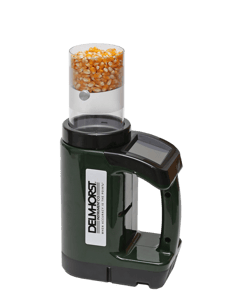Grain crops are often held in storage for extremely long periods of time. Before they can be stored, these crops have to be dried to prevent spoilage. However, over-drying grains can also have an impact on their nutritional value and your profits at the time of sale—you don’t want to give away free dry weight!
One way to prepare crops for long-term storage is to use a grain moisture tester to verify the moisture content (%MC) of grain prior to storage.
Testing Grain During the Drying Process

While you have your grain crops drying in your dehumidifiers (or similar equipment), it’s very important to closely monitor their moisture content throughout the process. Thankfully, this process is very simple with most grain moisture meters.
For example, the D999-FR uses a special “dump cell” to hold a sample of grain. All users have to do is fill a cup above the dump cell, level it off, and dump it into the cell to take a reading. The whole process takes mere moments—rather than the minutes or hours that weight-based oven-dry tests would require.
Because this test can be completed quickly and easily, it’s possible to frequently check different samples of grain—giving users the ability to better estimate the average %MC of all the grain they have in storage. With this information, it’s easier to pull grain out of the drying process when it’s at the optimum dryness to ensure quality without giving away free dry weight.
How frequently you check the moisture content of grain will depend on your drying method, the specific type of grain being tested and how close it is to reaching the desired %MC.
Mixing and Matching Grain for Storage
It may happen from time to time that one batch of grain gets over-dried despite your best efforts. In this case, it can be useful to mix a slightly “wetter” batch of grain with the dry batch to achieve an average moisture content closer to the ideal for that crop.
The University of Nebraska’s NebGuide has a methodology for determining the optimal mix of wet and dry grain. The simplified version is that the user takes the desired %MC they want to achieve and uses that to work backwards to determine how much of each of the wet and dry grain to use to reach that moisture content.
The long version of the formula has users take grains 1 and 2 and subtract their %MC value from the desired moisture content to establish their absolute difference from the desired value. These two numbers, A and B, are then added together to create a total, C. A and B will each be divided by C, then multiplied by 100 to determine the percentage of grain needed for the blend to be the right %MC overall.
So, if you wanted to reach 13% MC with grain at 10% MC and 18% MC, respectively, the steps of the formula would be:
- Determine Grain #1 Difference from Desired %MC: 13 – 10 = 3
- Determine Grain #2 Difference: 18 – 13 = 5
- Find Total Difference of Both Samples: 3 + 5 = 8
- Percentage of Grain 1: 3 / 8 = 0.375 x 100 = 37.5%
- Percentage of Grain 2: 5 / 8 = 0.625 x 100 = 62.5%
This would allow you to achieve the ideal moisture content for your long-term storage grain. Here, having a moisture meter would be crucial for getting the right data to plug into the above formula so you can get as close to your ideal moisture content as possible.
For farmers who need to store grain long-term, a moisture meter for grain is an indispensable tool for ensuring quality and avoiding giving away free dry weight—and thereby protecting the profitability of the crop.
Learn more about grain moisture testers—how to use them, and how to find the right ones—today!

Comments